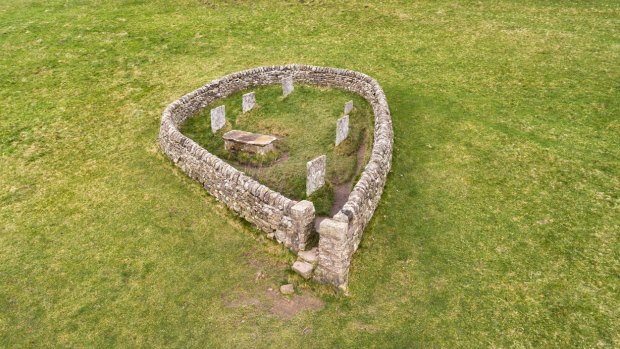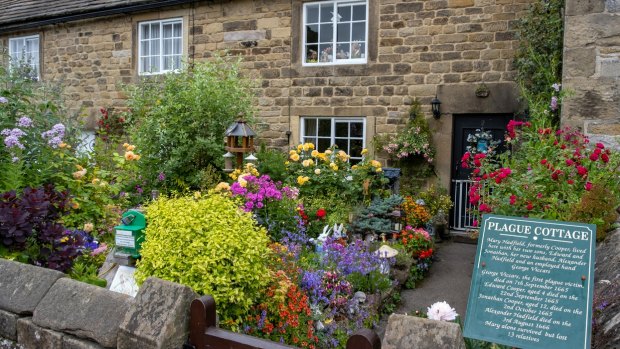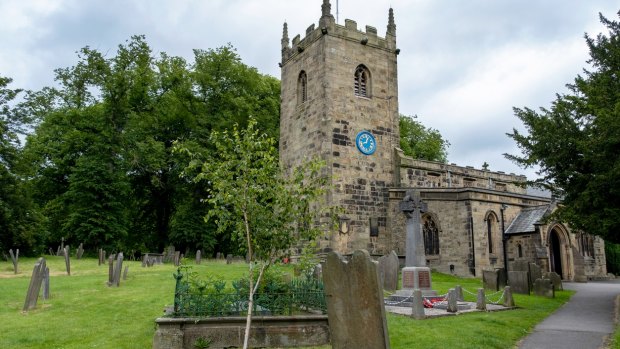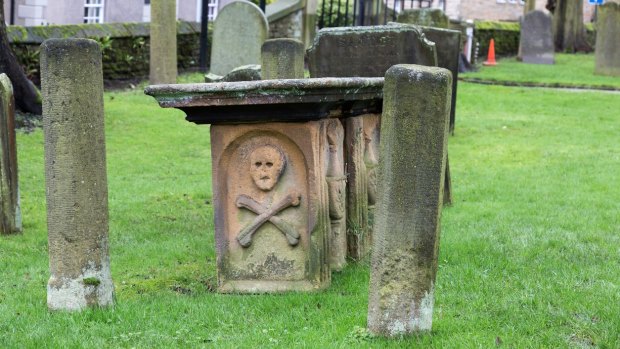This was published 4 years ago
Eyam, Derbyshire and coronavirus: The plague village that destroyed itself to save a nation in lockdown once again

The Riley Graves: The resting place of the Hancock family where during an eight-day period, six children and their father died from the bubonic plague that devastated the village of Eyam in 1665-66. Credit: iStock
For years, Eyam resident and retired churchwarden Joan Plant has acted as an unofficial tour guide of the famed Derbyshire plague village. The 73-year-old is among those still living here who can trace their family tree back to the "Great Plague", and the 14 long months between 1665 and 1666 when the residents of Eyam committed an extraordinary act of self-sacrifice by cutting themselves off from the outside world to prevent the infection spreading further.
During this dark and desperate period of self-isolation, Joan's own ancestor, Margaret Blackwell, contracted the disease. While delirious, she drank a jug containing scalding fat - yet miraculously survived. It is a story Joan has told many times to visitors and school groups, but one she never expected to be living herself. "It's unreal," she says, standing at the threshold of her 1616-built cottage which would have sheltered a family during the plague years, and where she has resided since the age of 12 and now finds herself under lockdown.
"Overall, 260 died of the plague here, and I now find myself thinking: 'Oh, please, Lord, don't let us get to 260 again'."

In 1665, residents of these cottages succumbed to the bubonic plague outbreak in the Peak District village of Eyam in Derbyshire, UK. Credit: Getty Images
Just as with the Black Death 350 years ago, COVID-19 has found its way to Eyam. There have been several suspected cases already reported among the village population of 1,300. Among them is the wife of the vicar Rev Mike Gilbert, who also suspects that he may have contracted a mild version of the disease.
Rev Gilbert's wife, a teacher in nearby Sheffield, has suffered a more virulent version and according to her husband, four weeks on from first falling ill is still not fully recovered and struggling with a cough and a tight chest - although she has not required hospital treatment.
Rev Gilbert, 58, who has been vicar of Eyam for the past seven years, is well aware of the historical parallels. In the graveyard of his church stands the memorial to Catherine Mompesson, the wife of the vicar of Eyam, William Mompesson, who died in the autumn of 1666 after contracting the plague. The recent weeks of lockdown have given cause to reflect on the letters Mompesson wrote following his wife's death.

Eyam parish church in Derbyshire.Credit: iStock
"The letters contain a real sense of will and purpose I find incredibly moving every time I read them," he says. "You could sense the weariness of being there administering for 14 months and the isolation still not ended. And yet within that is woven this real deep faith that she would go into heaven,"
The plague arrived here in September 1665 - via fleas secreted in a bundle of damp cloth ordered from London, which was opened up in a stone cottage next to the church. Of those living in what became known as the Plague Cottage, only a woman called Mary Hadfield survived, but lost 13 relatives, including her husband and two sons.
The following August - where deaths in the village reached a peak of half a dozen a day - another resident, Elizabeth Hancock, lost six of her children and her husband in the space of just eight days. She was forced to drag their bodies to bury them in a nearby field. Most of the Eyam plague victims lie in unmarked plots scattered around the countryside.

A tombstone in the church yard of the Parish Church of St Lawrence in the 'plague village' of Eyam, Derbyshire.Credit: iStock
Rev Gilbert still works in the original study used by Mompesson where, in 1665, he and fellow clergyman Thomas Stanley made the decision to place the village into lockdown. Today, Eyam Parish Church, which has a special plague window and a register of the dead on display, is closed for only the second time in its history (bar the odd bit of maintenance).
Last week, Rev Gilbert was also required to undertake his first funeral in the graveyard. It was for a well-loved resident, who died from cancer, and normally the church would have been packed. Instead, he was forced to conduct the service from the graveside with only immediate family in attendance. As the funeral cortege made its way to church, 100 or so villagers came to their doorsteps to stand in silent tribute.
During the plague isolation, each Sunday Mompesson would preach on a steep hill known as Cucklet Delph on the outskirts of the village which acts as a natural amphitheatre. Rev Gilbert says they discussed doing something similar during the coronavirus lockdown, but in the end felt it was too much of a risk, so have instead shifted church services online.
I first came to Eyam towards the end of February, when the first cases of coronavirus were starting to be reported across Britain.
Back then, the village had just been visited by a group of Chinese students from nearby Sheffield who wished to join in Sunday prayers for their suffering families at home. Today, Rev Gilbert admits he had no idea of what lay on the horizon for Eyam and the rest of the country. But aside from the concern of the impact of COVID-19 on its elderly population, there has also been real good that has emerged from the village's second lockdown.
"In some ways, we are more connected than we were," Rev Gilbert says. "There is definitely a greater openness, I think, of actually saying what is important in life and what will happen when I die?"
Joan Plant has seen the village coming together in different ways. Her 74-year-old husband, John, is a diabetic and they have been supported by local shops which have stayed open for residents. On Good Friday, a neighbour left three hot cross buns at the gate, and Joan has delivered cut flowers and scones for others she feels might be in need. "It's the little things that make a difference, and we are all trying to help each other out," she says.
Reporting for this paper over the past week from communities across the country, these are the stories of lockdown that have emerged time and again; of families coming together and neighbours and strangers helping each other through these dark times.
Joan admits she is refusing to allow herself too much time to think about life returning to normal. "I can't think about the end of lockdown because, if it's as serious as it was in 1665, then we're in for a long time," she says.
However, talk in the village sometimes strays into how to celebrate Eyam's survival of a second great epidemic. Throwing a giant street party seems to be the main consensus.
There will also be a service at Cucklet Delph - where the village congregation still gathers each year on the August Bank Holiday to remember how they came together during the plague.
Now they have a new enemy in their midst, and one day a new chapter in their history to celebrate - of how, once more, a small village stood firm.
The Telegraph, London
See also: How a village destroyed itself to save a nation
See also: The ancient city first to set up a modern quarantine system
Sign up for the Traveller newsletter
The latest travel news, tips and inspiration delivered to your inbox. Sign up now.